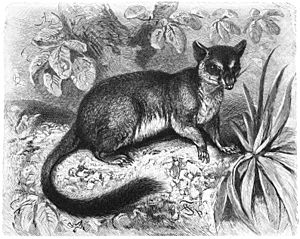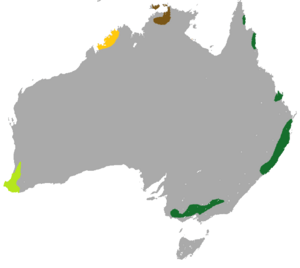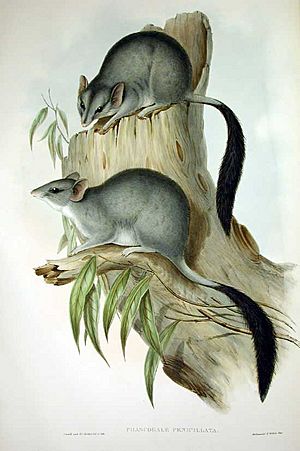Brush-tailed phascogale facts for kids
Quick facts for kids Brush-tailed phascogale |
|
|---|---|
 |
|
| Conservation status | |
| Scientific classification | |
| Genus: |
Phascogale
|
| Species: |
tapoatafa
|
| Subspecies | |
|
P. tapoatafa tapoatafa P. tapoatafa wambenger P. tapoatafa kimberleyensis P. pirata |
|
 |
|
The brush-tailed phascogale (Phascogale tapoatafa) is a small, rat-sized animal that lives in trees. It's a type of marsupial, which means it carries its babies in a pouch, like a kangaroo. People also call it the tuan or common wambenger. This animal is easy to spot because of the cool tuft of black, silky hair on the end of its tail. Sadly, male phascogales usually live for only about a year because they pass away after they reproduce.
Contents
About the Brush-tailed Phascogale Name
The brush-tailed phascogale was first described by a scientist named Friedrich Albrecht Anton Meyer in 1793. Later, another scientist, George Shaw, wrote more about it in 1800. For a while, people thought it was a type of opossum.
But in 1844, Coenraad Jacob Temminck created a new group just for it, called Phascogale. The scientific name, tapoatafa, comes from an Indigenous Australian name for this animal. It's also sometimes called Phascogale penicillata because of its brush-like tail.
Phascogale Subspecies
In 2015, scientists identified three different types, or subspecies, of the brush-tailed phascogale:
- P. t. tapoatafa: You can find this one in southeast Australia, from South Australia up to mid-coastal Queensland.
- P. t. wambenger: This subspecies lives in the southwest part of Western Australia.
- P. t. kimberleyensis: This type is found in the Kimberley region of Western Australia.
Another type, P. t. pirata, was confirmed to be its own separate species, now called the P. pirata. Scientists are still working to figure out which subspecies lives in the Cape York Peninsula.
What Does a Phascogale Look Like?
This phascogale has black fur. Its tail is covered with long black hairs on the bottom half. These hairs can stand up, making the tail look like a bottle brush!
The main part of its body is about 16 to 27 centimeters (about 6 to 11 inches) long. Its tail adds another 16 to 24 centimeters (about 6 to 9 inches) to its length. Male phascogales are bigger than females. Males can weigh up to 310 grams (about 11 ounces), while females usually weigh less than 210 grams (about 7.4 ounces).
Where Do Phascogales Live?
Brush-tailed phascogales live in many parts of Australia, but their homes are spread out. They are not found in Tasmania.
Sadly, their numbers have dropped a lot. They are believed to have disappeared from about half of the areas where they used to live. This is mainly because their homes (habitats) are being destroyed. Also, predators like the red fox and wild cat hunt them. Because of these threats, they are very vulnerable to disappearing from local areas.
Phascogale Conservation Status
In New South Wales, the brush-tailed phascogale is listed as a vulnerable species. This means it needs protection. However, the IUCN Red List (a global list of threatened species) currently lists it as Near Threatened. This means it might become threatened in the future, but it's not considered endangered right now.
What Do Phascogales Eat?
The brush-tailed phascogale is a hunter that is active at night. It lives in trees and finds its food there.
It eats:
- Smaller mammals
- Birds
- Lizards
- Insects, especially spiders
It also likes to drink nectar from flowering trees. Sometimes, people have reported them trying to catch chickens from farms.
How Do Phascogales Reproduce?
Brush-tailed phascogales usually have their babies between June and August. This is when the females are ready to have young.
A unique and sad fact about male brush-tailed phascogales is that they typically do not live past their first year. They usually pass away after a very busy period of mating. This is often due to the extreme effort and stress involved. However, some males living in zoos have lived longer, up to three years, but they couldn't have babies after their first year.
Female phascogales make their nests in hollow trees. They usually have litters of 7 to 8 young. The young phascogales stay in the nest with their mother until they are about 5 months old.
See also
 In Spanish: Fascogalo de cola de cepillo para niños
In Spanish: Fascogalo de cola de cepillo para niños



